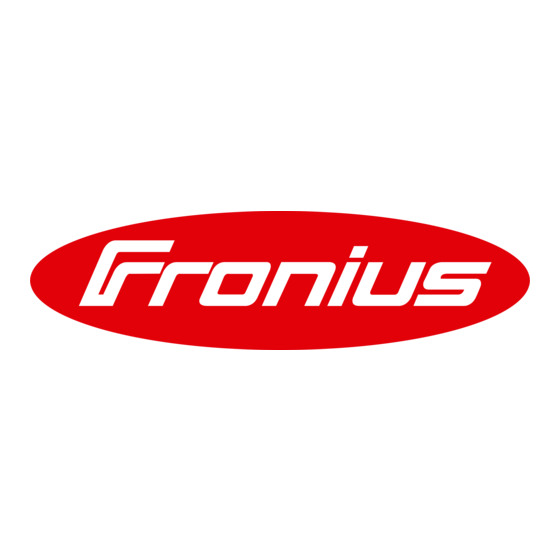
Table of Contents
Advertisement
Quick Links
/ Perfect Charging / Perfect Welding /
Fronius Primo
3.0-1 / 3.5-1 / 3.6-1 / 4.0-1
4.6-1 / 5.0-1 AUS / 5.0-1
5.0-1 SC / 6.0-1 / 8.2-1
Dummy
42,0410,2148
Solar Energy
008-25042018
Operating Instructions
Grid-connected inverter
Instructions de service
Onduleur pour installations photo-
voltaïques connectées au réseau
Gebruiksaanwijzing
Inverter voor netstroomgekoppelde
fotovoltaïsche installaties
Advertisement
Table of Contents

Summarization of Contents
Introduction
Explanation of safety symbols
Defines warning symbols (Danger, Warning, Caution, Note, Important) for user safety.
Safety rules
Qualified service engineers
Outlines requirements for service personnel and emphasizes authorized actions.
Environmental conditions
Specifies operational and storage conditions and manufacturer liability.
EMC measures
Addresses device compliance with electromagnetic compatibility standards.
General
Device concept
Explains the inverter's physical components and its core function of converting DC to AC power.
Proper use/intended purpose
Defines the inverter's exclusive use in grid-connected photovoltaic systems and lists prohibited actions.
Warning notices on the device
Highlights the presence and importance of warning labels and safety symbols on the inverter.
Data communication and Fronius Solar Net
Fronius Solar Net and data interface
Describes Fronius Solar Net as a data network for linking inverters and system add-ons.
Data communication area
Details the physical connections for data communication, including RS 422 interfaces.
Explanation of the multifunction current interface
Explains the functionality and wiring variants of the multifunction current interface.
System monitoring
General
Introduces the standard WLAN-enabled system monitoring features of the inverter.
Using for the first time
Provides steps for initial setup and connection using the Solar.web App or web browser.
Controls and indicators
Monitoring and status LEDs
Details the function of the General Status, Startup, and Operating Status LEDs.
Function keys
Explains the navigation and selection functions of the key buttons on the inverter.
The menu level
Activate display backlighting
Explains how to activate the display's backlighting feature.
Open menu level
Describes the process of accessing and navigating the inverter's menu system.
The NOW, LOG and GRAPH menu items
Values displayed in the NOW and LOG menu items
Lists the specific data points displayed in the NOW and LOG menu sections.
SETUP menu item
Initial setting
Notes that initial settings are automated but can be adjusted via the SETUP menu.
Navigating in the SETUP menu item
Details how to enter and navigate through the SETUP menu options.
Setting entries on the Setup menu, general
Explains the general procedure for modifying settings within the SETUP menu.
The Setup menu items
Standby
Describes how to manually activate and deactivate the inverter's standby mode.
WiFi Access Point
Explains how to activate and deactivate the WLAN access point for system monitoring.
USB
Details specifications and procedures for using USB sticks for data logging and software updates.
Display settings
Covers options for language, night mode, contrast, and illumination of the display.
The INFO menu item
Measured values
Lists various measured DC and AC values available for display.
PSS status
Explains how to view the status of the most recent inverter fault.
Grid status
Describes how to view the five most recent grid faults detected by the inverter.
Device information
Details information relevant to power supply companies, including country setup.
Switching the key lock on and off
General
Explains the key lock function to prevent unauthorized access to setup data.
USB Stick as a Data Logger and for Updating Inverter Software
USB flash drive as a datalogger
Details how a USB flash drive functions as a datalogger for storing and exporting data.
Suitable USB flash drives
Provides recommendations for compatible USB flash drives and supported file systems.
USB stick for updating the inverter software
Outlines the procedure for updating the inverter's software using a USB stick.
Remove USB stick
Provides security notes for safely removing a USB stick to prevent data loss.
The Basic menu
General
Lists parameters important for installing and operating the inverter via the Basic menu.
Access the Basic menu
Guides the user on how to access the Basic menu using an access code.
Items on the Basic menu
Details the specific configuration options available within the Basic menu.
Status diagnostics and troubleshooting
Displaying status codes
Explains how the inverter performs self-diagnosis and displays status codes for faults.
Class 1 status codes
Describes transient status codes caused by grid conditions, not device faults.
Status codes - Class 4
Lists class 4 status codes that often require intervention by a trained service technician.
Technical data
Input data
Lists technical specifications for the inverter's DC input parameters.
Output data
Details the technical specifications for the inverter's AC output parameters.
General data
Provides general technical specifications such as efficiency, dimensions, and operating conditions.
Protection devices
Outlines the integrated protection mechanisms within the inverter.
Applicable standards and guidelines
CE mark
Confirms compliance with relevant EU directives and the right to display the CE mark.
Circuit to prevent stand-alone operation
Explains the inverter's built-in circuit to prevent operation without a grid connection.
Grid failure
Describes how the inverter interrupts energy feed-in upon grid failure for safety.
Warranty terms and conditions, and disposal
Fronius manufacturer's warranty
Provides information on obtaining detailed country-specific warranty terms online.
Disposal
Details Fronius's commitment to taking back old devices for appropriate recycling.
















Need help?
Do you have a question about the Primo 8.2-1 Dummy and is the answer not in the manual?
Questions and answers